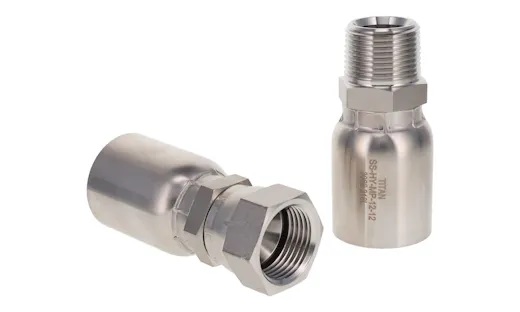Introduction
Hydraulic systems depend on reliable and secure connections between hoses and equipment. The end fittings on hydraulic hoses are essential for ensuring these connections remain tight, even under high pressure, preventing leaks or failures. This blog will explore six common types of hydraulic hose end fittings: crimp fittings, hose barbs, push-lock fittings, quick connects, compression fittings, and reusable fittings. We’ll examine their design, advantages, and typical uses to help you choose the best option for your application.
1. Crimp Fittings
Design: Crimp fittings are permanently attached by using a crimping machine to deform the fitting around the hose, creating a strong, leak-proof seal. They can be made from materials like stainless steel, brass, or other alloys, depending on the application.
Applications: These fittings are ideal for high-pressure environments such as industrial machinery, automotive systems, and heavy equipment where long-term reliability is key. They are not intended for frequent disconnection.
Benefits: Crimp fittings offer a durable, secure connection that minimizes the risk of leaks. They come in various sizes and configurations, making them suitable for a wide range of hydraulic setups.
Shop Crimp Fittings
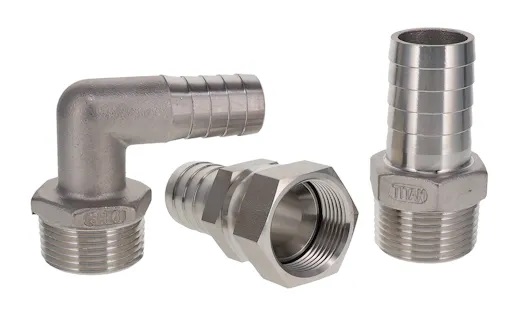
2. Hose Barbs
Design: Hose barbs feature a ridged stem that fits into the hose, usually secured with a clamp. Installation requires no special tools, making them ideal for quick repairs or temporary setups.
Applications: Commonly used in low to medium pressure systems like residential water lines, workshop air hoses, and agricultural fluid transfer.
Benefits: Simple to install, cost-effective, and perfect for situations where frequent changes are needed without complex tools.
Shop Hose Barbs
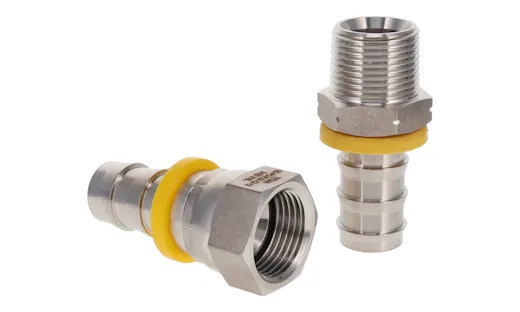
3. Push-Lock Barbs
Design: Push-lock barbs allow for tool-free installation. The hose simply slides onto the fitting until it locks into place, thanks to an internal gripping mechanism.
Applications: Suitable for low-pressure hydraulic and pneumatic systems, such as automotive air systems, and fluid lines in industrial settings requiring easy assembly and disassembly.
Benefits: Quick to use, reduces downtime, and offers a clean look. Ideal for systems that may need frequent reconfiguration.
Shop Push-Lock Barbs
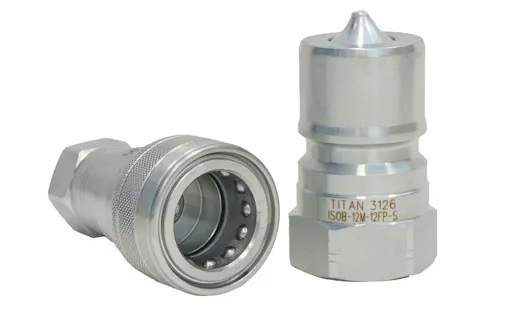
4. Quick Connects
Design: Quick connect fittings allow for fast, tool-free connection and disconnection using a push-pull mechanism. They typically consist of male and female parts that lock together securely.
Applications: Used in applications requiring frequent hose changes, such as construction equipment, chemical plants, and agricultural machinery.
Benefits: Minimizes downtime and fluid loss during disconnection. Perfect for handling hazardous or expensive fluids efficiently.
Shop Quick Connects
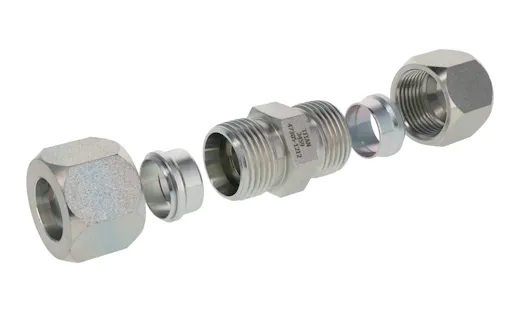
5. Compression Fittings
Design: Compression fittings use a nut and ferrule to compress the hose when tightened, forming a tight seal. No flaring is required, making them simple to install.
Applications: Ideal for medium-pressure systems like fuel lines, refrigeration, and general hydraulic setups where clean, removable connections are needed.
Benefits: Leak-proof, easy to assemble without special tools, and durable. Great for systems requiring regular maintenance or adjustments.
Shop Compression Fittings
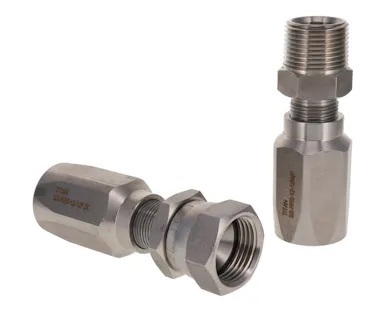
6. Reusable Hose Fittings
Design: Reusable fittings are designed for field assembly and disassembly. They typically include a body, socket, and sometimes a nipple, allowing the hose to be secured through threading.
Applications: Often used in emergency repairs, remote locations, or situations where hoses need to be reused frequently, such as marine, construction, and field service work.
Benefits: Cost-effective, flexible, and eco-friendly. They reduce downtime and eliminate the need for expensive crimping tools, making them a sustainable choice.
Shop Reusable Hose Fittings
Conclusion
Choosing the right hydraulic hose end fitting is essential for ensuring the efficiency, safety, and longevity of your system. Each type of fitting has its own strengths and ideal use cases. Whether you're looking for permanent connections, ease of use, or flexibility, understanding the options available helps you make informed decisions that meet your specific needs.
Q & A
Q1: What are hydraulic hose end fittings used for?
A1: Hydraulic hose end fittings connect hoses to components like pumps, valves, and cylinders, ensuring secure, leak-free connections under high pressure.
Q2: How do you choose the right hydraulic hose end fitting?
A2: Consider factors like pressure requirements, compatibility with the hose and fluid, environmental conditions, and the specific application needs, such as vibration or mechanical stress.
Q3: Can hydraulic hose end fittings be reused?
A3: Some, like reusable or field-attachable fittings, can be reused. Crimp fittings, however, are permanently fixed and cannot be reused once removed.
Q4: What is the difference between crimp and reusable fittings?
A4: Crimp fittings are permanently attached using a crimping machine, while reusable fittings can be manually assembled and disassembled without special tools.
Q5: Why would you use a quick connect fitting in a hydraulic system?
A5: Quick connect fittings are ideal for systems requiring frequent disconnections and reconnections without tools, reducing downtime and fluid loss during maintenance.
Rapid Prototyping,Stainless Machining,Numerical Control Machining,Graphite Ultrasonic Stainless Machining
JING SUNG Precision CO., , https://www.jingsungcnc.com
